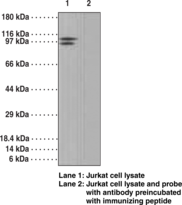| Formulation |
100 µg of protein G-purified IgG in 200 µl PBS containing 0.2% gelatin and 0.05% sodium azide |
| Stability |
1 year |
| Storage |
-20°C |
| Shipping |
Wet ice
in continental US; may vary elsewhere
|
| Specificity |
| Canine LSD1 |
+ |
| Human LSD1 |
+ |
| Murine LSD1 |
+ |
| Rat LSD1 |
+ |
| Rhesus monkey LSD1 |
+ |
Show all 5
Hide all but first 3
|
| Size |
Global Purchasing |
| 1 ea |
|
Description
Antigen:
synthetic peptide from human LSD1 with the range of amino acids 800-850
·
Host:
rabbit
·
Application(s):
WB and IHC (paraffin-embedded sections)
·
LSD1, the first known lysine-specific histone demethylase, is an 886 amino acid nuclear protein belonging to the flavin monoamine oxidase family. It contains a SWIRM domain, a FAD-binding motif and an amine oxidase domain. This protein is ubiquitously expressed and is a component of several histone deacetylase complexes. LSD1 acts as a component of the CoREST and other transcriptional co-repressor complexes and also plays an important role in silencing neuronal-specific genes in non-neuronal cells. It is also known to demethylate Lys4 of histone H3, a specific tag for epigenetic transcriptional activation. Reports suggest that LSD1 plays an important role in stimulating androgen-receptor-dependent transcription converting oxygen to hydrogen peroxide (might use alternative electron acceptors). Along with nuclear FHL2, it serves as a novel biomarker predictive for prostate cancer.






